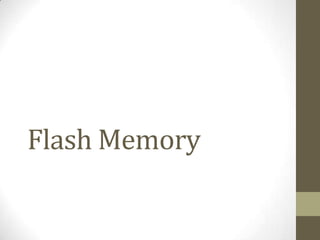
10 flash memory
- 1. Flash Memory
- 2. Flash Memory • a type of EEPROM(Electronically Erasable Programmable Read Only Memory) chip • It has a grid of columns and rows with a cell that has two transistors at each intersection
- 3. • The two transistors are separated from each other by a thin oxide layer. One of the transistors is known as a floating gate, and the other one is the control gate. The floating gate's only link to the row, or wordline, is through the control gate. As long as this link is in place, the cell has a value of 1. To change the value to a 0 requires a curious process called Fowler-Nordheim tunneling.
- 5. Flash Memory: Tunneling and Erasing • Tunneling is used to alter the placement of electrons in the floating gate. • An electrical charge(10 – 13 volts) is applied to the floating gate. The charge comes from the column, or bitline, enters the floating gate and drains to a ground.
- 6. • This charge causes the floating-gate transistor to act like an electron gun. The excited electrons are pushed through and trapped on other side of the thin oxide layer, giving it a negative charge. These negatively charged electrons act as a barrier between the control gate and the floating gate. A special device called a cell sensor monitors the level of the charge passing through the floating gate.
- 7. • If the flow through the gate is above the 50 percent threshold, it has a value of 1. When the charge passing through drops below the 50-percent threshold, the value changes to 0. A blank EEPROM has all of the gates fully open, giving each cell a value of 1.
- 8. • The electrons in the cells of a flash-memory chip can be returned to normal ("1") by the application of an electric field, a higher-voltage charge. Flash memory uses in-circuit wiring to apply the electric field either to the entire chip or to predetermined sections known as blocks. This erases the targeted area of the chip, which can then be rewritten. Flash memory works much faster than traditional EEPROMs because instead of erasing one byte at a time, it erases a block or the entire chip, and then rewrites it.
- 9. Removable Flash Memory Cards • It has no moving parts, so it's noiseless. • It allows faster access. • It's smaller in size and lighter. • The cost per megabyte for a hard disk is drastically cheaper, and the capacity is substantially more.
- 10. Solid-state floppy-disk card • The solid-state floppy-disk card (SSFDC), better known as SmartMedia, was originally developed by Toshiba. SmartMedia cards are available in capacities ranging from 2 MB to 128 MB. The card itself is quite small, approximately 45 mm long, 37 mm wide and less than 1 mm thick.
- 11. • A plane electrode is connected to the flash-memory chip by bonding wires. The flash-memory chip, plane electrode and bonding wires are embedded in a resin using a technique called over-molded thin package (OMTP). This allows everything to be integrated into a single package without the need for soldering.
- 12. • SmartMedia cards erase, write and read memory in small blocks (256- or 512-byte increments) • Because of newer, smaller cards with bigger storage capacities, such as xD-Picture Cards and Secure Digital cards, Toshiba has essentially discontinued the production of SmartMedia cards, so they're now difficult to find. • Looking at the card with the electrode facing up, if the notch is on the left side, the card needs 5 volts. If the notch is on the right side, it requires 3.3 volts.
- 13. CompactFlash • CompactFlash cards were developed by Sandisk in 1994, and they're different from SmartMedia cards in two important ways: • They're thicker. • They utilize a controller chip.
- 14. • CompactFlash consists of a small circuit board with flash-memory chips and a dedicated controller chip, all encased in a rugged shell that is thicker than a SmartMedia card. CompactFlash cards are 43 mm wide and 36 mm long, and come in two thicknesses: Type I cards are 3.3 mm thick, and Type II cards are 5.5 mm thick.
- 15. • CompactFlash cards support dual voltage and will operate at either 3.3 volts or 5 volts. • The increased thickness of the card allows for greater storage capacity than SmartMedia cards. CompactFlash sizes range from 8 MB to as much as 100GB. The onboard controller can increase performance, particularly in devices that have slow processors. The case and controller chip add size, weight and complexity to the CompactFlash card when compared to the SmartMedia card.
